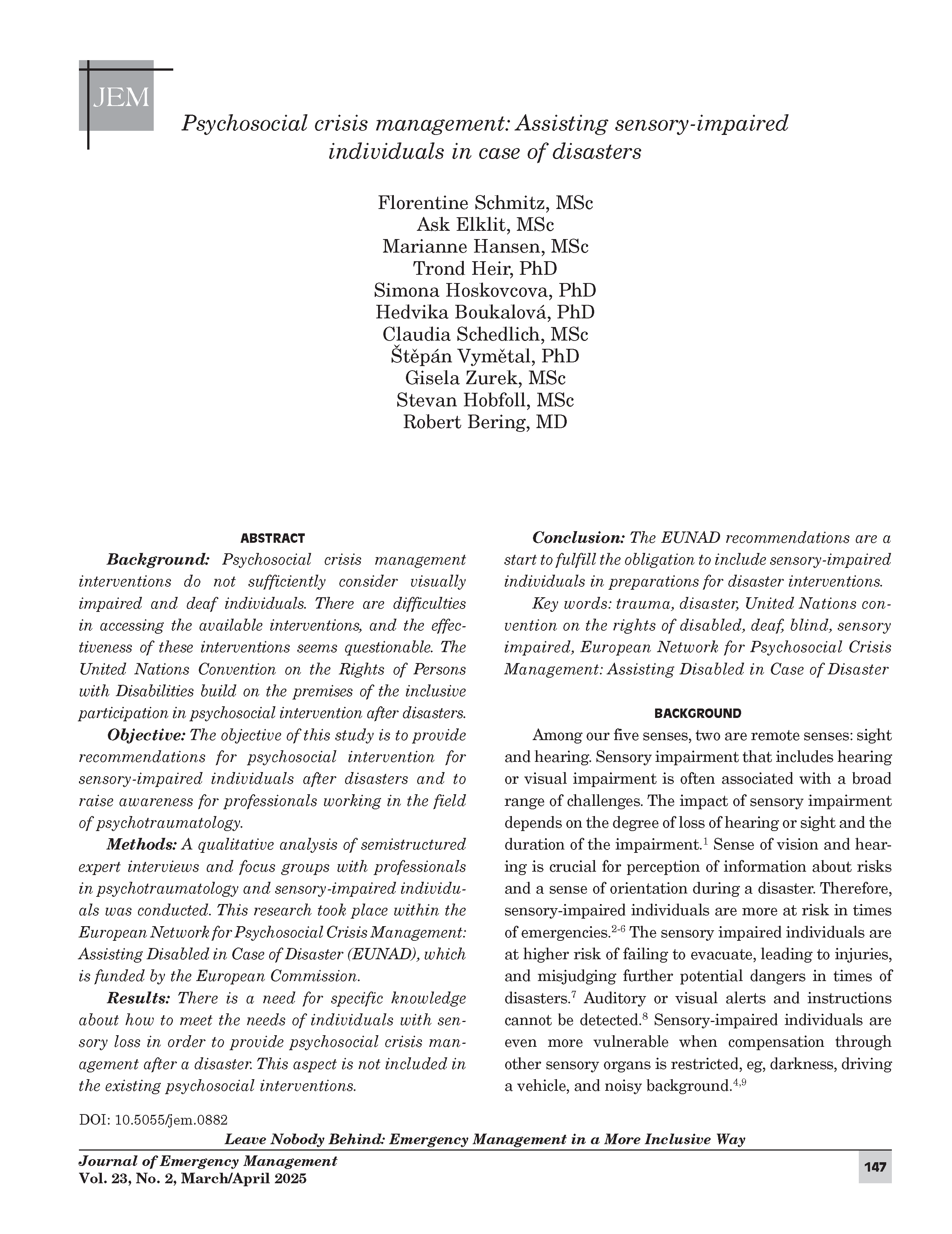Psychosocial crisis management: Assisting sensory-impaired individuals in case of disasters
DOI:
https://doi.org/10.5055/jem.0882Keywords:
trauma, disaster, United Nations convention on the rights of disabled, deaf, blind, sensory impaired, European Network for Psychosocial Crisis Management: Assisting Disabled in Case of DisasterAbstract
Background: Psychosocial crisis management interventions do not sufficiently consider visually impaired and deaf individuals. There are difficulties in accessing the available interventions, and the effectiveness of these interventions seems questionable. The United Nations Convention on the Rights of Persons with Disabilities build on the premises of the inclusive participation in psychosocial intervention after disasters.
Objective: The objective of this study is to provide recommendations for psychosocial intervention for sensory-impaired individuals after disasters and to raise awareness for professionals working in the field of psychotraumatology.
Methods: A qualitative analysis of semistructured expert interviews and focus groups with professionals in psychotraumatology and sensory-impaired individuals was conducted. This research took place within the European Network for Psychosocial Crisis Management: Assisting Disabled in Case of Disaster (EUNAD), which is funded by the European Commission.
Results: There is a need for specific knowledge about how to meet the needs of individuals with sensory loss in order to provide psychosocial crisis management after a disaster. This aspect is not included in the existing psychosocial interventions.
Conclusion: The EUNAD recommendations are a start to fulfill the obligation to include sensory-impaired individuals in preparations for disaster interventions.
References
Du Feu M, Fergusson K: Sensory impairment and mental health. Adv Psychiatr Treat. 2003; 9: 95-103.
Gerber E: Describing tragedy: The information access needs of blind people in emergency-related circumstances. Hum Organ. 2009; 68(1): 73-81.
Neuhauser L, Ivey S, Huang D, et al.: Availability and readability of emergency preparedness materials for deaf and hard-of-hearing and older adult populations: Issues and assessments. PLoS One. 2013; 8: E55614. DOI: 10.1371/journal.pone.0055614.
Stout C, Heppner C, Brick K: Emergency preparedness and emergency communication access. Lessons learned since 9/11 and recommendations. 2004. Available at https://tap.gallaudet.edu/emergency/Nov05Conference/EmergencyReports/DHHCANEmergencyReport.pdf. Accessed August 22, 2024.
Sullivan MT, Häkkinen HT: Disaster preparedness for vulnerable populations: Determining effective strategies for communicating risk, warning, and response. In Third Annual Magrann Research Conference at Rutgers University. 2006; 4: 1-36. Available at https://www.researchgate.net/publication/317267717_Disaster_preparedness_for_vulnerable_populations_Determining_effective_strategies_for_communicating_risk_warning_and_response. Accessed August 22, 2024.
Fellinger J, Holzinger D, Pollard R: Mental health of deaf people. The Lancet. 2012; 379: 1037-1044.
Legood R, Scuffham P, Cryer C: Are we blind to injuries in the visually impaired? A review of the literature. Inj Prev. 2002; 8: 155-160.
Ulmasova I, Silcock N, Schranz B: Mainstreaming disability into disaster risk reduction: A training manual. 2009. Available at https://www.preventionweb.net/publication/mainstreamingdisability-disaster-risk-reduction-training-manual. Accessed August 22, 2024.
US Department of Education: Emergency management research and people with disabilities: A resource guide. 2008. Available at https://www2.ed.gov/rschstat/research/pubs/guide-emergency-management-pwd.pdf. Accessed August 22, 2024.
United Nations: UN convention on the rights of persons with disabilities. 2009. Available at https://social.desa.un.org/issues/disability/crpd/convention-on-the-rights-of-persons-with-disabilities-crpd. Accessed August 22, 2024.
Hobfoll SE, Watson P, Bell CC, et al.: Five essential elements of immediate and mid-term mass trauma intervention. Empirical evidence. Psychiatry. 2007; 70: 283-315.
Centre for Research on the Epidemiology of Disasters: Disasters in numbers. 2023. Available at https://www.un-spider.org/news-andevents/news/cred-publication-2023-disasters-numbers-significantyear-disaster-impact. Accessed August 22, 2024.
Fischer G, Riedesser P: Lehrbuch Der Psychotraumatologie [Handbook of Psychotraumatology]. München: Reinhardt, 2009.
Juen B, Siller H, Gstrein S: Psychosoziale intervention für akut traumatisierte personen und deren wirksamkeit [Psychosocial interventions for acute traumatized humans and its effectiveness]. J Psychol. 2011; 19: 1-28. Accessed August 22, 2024.
EUNAD: EUNAD European network for psychosocial crisis management: Assisting disabled in case of disaster. 2014. Available at https://eunad-info.eu/home.html.
United States Fire Administration: Orientation Manual for First Responders on the Evacuation of People with Disabilities. Maryland: Federal Emergency Management Agency, 2002.
Steinberg A, Barnett S, Meador H, et al.: Health care system accessibility: Experience and perceptions of deaf people. J Gen Intern Med. 2006; 21: 260-266.
Engelman A, Ivey S, Tseng W, et al.: Neuhauser: Responding to the deaf in disasters: Establishing the need for systematic training for state level emergency management agencies and community organizations. BMC Health Serv Res. 2013; 13: 84-94.
Scheier D: Barriers to health care for people with hearing loss: A review of the literature. J N Y State Nurses Assoc. 2009; 40: 4-10.
Demmin DL, Silverstein SM: Visual impairment and mental health: Unmet needs and treatment options. Clin Ophthalmol. 2020; 14: 4229-4251.
Bering R, Schedlich C, Zurek G: Großschadenslagen als potentiell traumatisierende Ereignisse [Disasters as potentially traumatizing events] & Situationstypologien der Psychosozialen Notfallversorgung [Psychosocial intervention in specific contexts]. In Seidler G, Freyberger H, Maercker A (eds.): Handbuch Der Psychotraumatologie [Handbook of Psychotraumatology]. Stuttgart: Klett-Cotta, 2011: 493-507, 644-658.
Saur R, Hansen MB, Jansen A, et al.: Visually impaired individuals, safety perceptions and traumatic events: A qualitative study of hazards, reactions and coping. Disabil Rehabil. 2017; 39(7): 691-696.
Miles M, Huberman M, Saldana J: Qualitative Data Analysis. A Methods Sourcebook. Los Angeles: Sage, 2014. Available at https://journals.plos.org/plosone/article?id=10.1371/journal.pone.0055614.
Mayring P: Qualitative Inhaltsanalyse. Grundlagen Und Techniken [Qualitative Content Analysis, Basics and Techniques]. Weinheim: Beltz, 2010.
Trezek B, Mayer C: Reading and deafness: State of the evidence and implications for research and practice. Educ Sci. 2019; 9(3): 216.
Witteveen AB, Bisson JI, Ajdukovic D, et al.: Post-disaster psychosocial services across Europe: The TENTS project. Soc Sci Med. 2012; 75(9): 1708-1714.
Flick U: Design und Prozess qualitativer Forschung [Design and process of qualitative research]. In Flick U, Von Kardoff E (eds.): Qualitative Forschung. Ein Handbuch. 9th ed. Reinbeck Bei Hamburg: Rowohlt, 2012: 252-265.
Federal Office of Civil Protection and Disaster Assistance in Germany: Assisting people with disabilities in case of disaster. 2017. Available at https://www.researchgate.net/publication/334285728_Assisting_People_with_Disabilities_in_Case_of_Disaster. Accessed August 22, 2024.

Published
How to Cite
Issue
Section
License
Copyright 2007-2025, Weston Medical Publishing, LLC and Journal of Emergency Management. All Rights Reserved.





